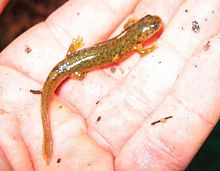
The torrent salamanders or Cascade salamanders are a family of salamanders (Rhyacotritonidae) with only one genus, Rhyacotriton. The torrent salamanders are endemic to the United States in the Pacific Northwest.
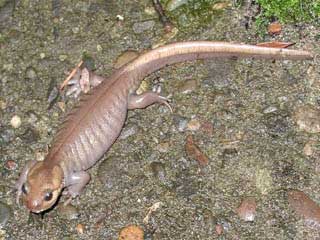
The northwestern salamander is a species of mole salamander that inhabits the northwest Pacific coast of North America. These fairly large salamanders grow to 8.7 in (220 mm) in length. It is found from southeastern Alaska on May Island, through Washington and Oregon south to the mouth of the Gualala River, Sonoma County, California. It occurs from sea level to the timberline, but not east of the Cascade Divide. Its range includes Vancouver Island in British Columbia and The San Juan Islands, Cypress, Whidbey, Bainbridge, and Vashon Islands in Washington.

The long-toed salamander is a mole salamander in the family Ambystomatidae. This species, typically 4.1–8.9 cm (1.6–3.5 in) long when mature, is characterized by its mottled black, brown, and yellow pigmentation, and its long outer fourth toe on the hind limbs. Analysis of fossil records, genetics, and biogeography suggest A. macrodactylum and A. laterale are descended from a common ancestor that gained access to the western Cordillera with the loss of the mid-continental seaway toward the Paleocene.
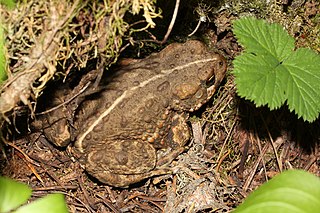
The western toad is a large toad species, between 5.6 and 13 cm long, native to western North America. A. boreas is frequently encountered during the wet season on roads, or near water at other times. It can jump a considerable distance for a toad. Breeding occurs between March and July in mountainous areas, and as early as January in lower-elevation regions. The female lays up to 17,000 eggs stuck together in strings that adhere to vegetation and other objects along water edges.
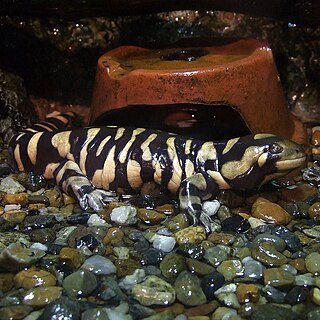
The barred tiger salamander or western tiger salamander is a species of mole salamander that lives in lower western Canada, the western United States and northern Mexico.

Van Dyke's salamander is a small woodland salamander in the family Plethodontidae, the lungless salamanders. These animals breathe through their skin and are largely terrestrial. Compared to other salamanders in Plethodon it is relatively stocky with long legs. Usually associated with streams, seepages, and rock outcrops, it is endemic to Washington where it is found in a limited number of small, isolated populations.

The Cheat Mountain salamander is a species of small woodland salamander found only on Cheat Mountain, and a few nearby mountains, in the eastern highlands of West Virginia. It and the West Virginia spring salamander are the only vertebrate species with geographic ranges restricted to that state.
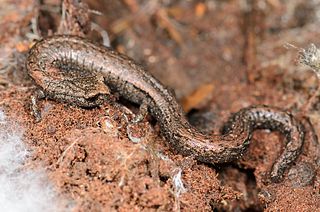
The gregarious slender salamander is a species of salamander in the family Plethodontidae. Its natural habitats are California interior chaparral and woodlands and temperate grasslands in the lower foothills of the western Sierra Nevada and the eastern Central Valley in California, United States.

The seepage salamander is a small, terrestrial species of salamander in the family Plethodontidae. It is endemic to the United States. They are found in small areas of Tennessee, North Carolina, Georgia, and Alabama. Its natural habitats are temperate forests, intermittent rivers, and freshwater springs. It gets its name from the seepages around which it lives. It is very similar in its appearance and life history to the pygmy salamander. These two species differ greatly from the other Desmognathus species. They are the smallest salamanders in the genus, measuring only 3–5 cm (1–2 in) in length. They are also the only two terrestrial, direct-developing Desmognathus species. However, the two species are not often seen to coexist, differing in distribution by elevation; although there are exceptions. The seepage salamander is currently listed as Near Threatened, with its numbers declining in most of states in which it is found. It is threatened by habitat loss, with logging having a major effect.

Desmognathus fuscus is a species of amphibian in the family Plethodontidae. The species is commonly called the dusky salamander or northern dusky salamander to distinguish it from populations in the southern United States which form several distinct species, the southern dusky salamanders. The northern dusky salamander is the most widespread representative of its genus in Canada. It can be found in eastern North America from extreme eastern Canada in New Brunswick south to South Carolina. The size of the species' total population is unknown, but is assumed to easily exceed 100,000. The species' habitat differs somewhat geographically; dusky salamanders in the northern part of the range prefer rocky woodland streams, seepages, and springs, while those in the south favor floodplains, sloughs, and muddy places along upland streams. They are most common where water is running or trickling. They hide under various objects, such as leaves or rocks, either in or near water. Alternatively, they may enter burrows for protection. The dusky salamander lays its eggs close to water under moss or rocks, in logs, or in stream-bank cavities. The larval stage which follows is normally aquatic.

The Peaks of Otter salamander is a species of salamanders in the family Plethodontidae. It is endemic to the Peaks of Otter area in the Blue Ridge Mountains of Virginia. It is a montane salamander found at elevations above 442 m (1,450 ft), but more commonly above 760 m (2,490 ft). It can be locally common, but its distribution is small and patchy. This makes it vulnerable to local threats such as timber harvesting, recreational development, defoliation by gypsy moths, and spraying to control the latter.

The California giant salamander is a species of salamander in the family Ambystomatidae. Dicamptodon ensatus is endemic to California, in the western United States. The species once additionally included individuals now belonging to the species D. aterrimus and D. tenebrosus, under the common name Pacific giant salamander, which now refers to the genus and family.

The Cascade torrent salamander is a species of salamander in the family Rhyacotritonidae. It is endemic to the Pacific Northwest in the United States where it is found from Skamania County in Washington south to Lane County in Oregon on the west slope of the Cascade Mountains.
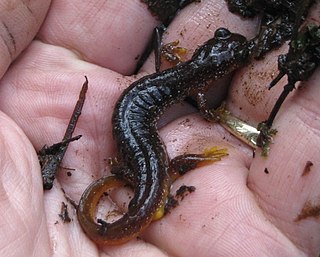
The Columbia torrent salamander is a species of salamander in the family Rhyacotritonidae, endemic to the Pacific Northwest in the United States. It is found in the coastal areas of Washington to northwestern Oregon.
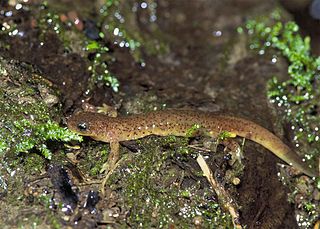
The Olympic torrent salamander is a species of salamander in the family Rhyacotritonidae. This is a small salamander that lives in clear, cold, mountain streams. It is medium to dark brown and may have a few small light spots on the sides and small dark spots on the tail; it is bright yellow on the belly, usually with some dark spots. Torrent salamanders typically have short snouts and relatively large eyes. As in other torrent salamanders, adult males have square-edged lobes behind the cloaca. These salamanders live at the edges of clear, cold, mountain streams; they can be abundant under gravel at stream edges and in the spray zones of waterfalls. During rainy seasons, they are occasionally found under objects on land away from streams.

There are 14 species of amphibians and 5 species of reptiles known to occur in Mount Rainier National Park.
